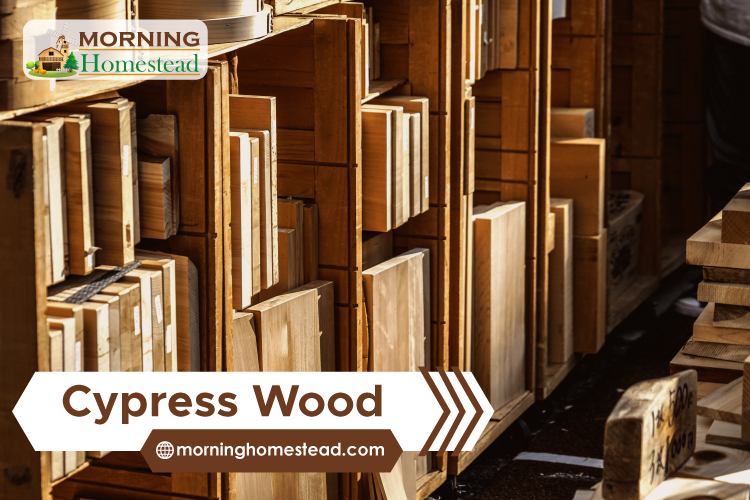Last Updated on August 11, 2023 by Georgie Smith
Cypress wood is a type of softwood that is native to the southeastern United States. It is known for its durability, rot resistance, and workability. Cypress wood is often used for outdoor applications, such as decks, siding, and fencing. It can also be used for interior applications, such as flooring and cabinetry.
It is popular for various applications, from construction to durable outdoor furniture making and decorative accents. This article explores Cypress’s many characteristics and uses, as well as its cultural significance and benefits for outdoor and indoor projects.
Characteristics
Cypress wood is known for its unique and desirable characteristics. The wood is highly resistant to decay and insect damage, making it ideal for outdoor applications. It is also noted for its beautiful color, which ranges from light brown to reddish-brown.
Its tight, straight grain pattern creates a smooth and consistent texture pleasing to the eye and the touch. The wood also has a pleasant earthy scent.
It is versatile and can be easily machined, sanded, and finished, allowing for various applications, from simple outdoor furniture to ornate carvings and decorative details. Its durability, beauty, and versatility make it popular for various projects.
Where does it come from?
Cypress wood comes from the bald cypress tree, which is a deciduous conifer tree that grows in wet, swampy areas, mostly in the southeastern United States. They can be found all along the Atlantic Coastal Plain, along the Gulf of Mexico, and up the Mississippi River Valley.
These trees grow in swamps, wetlands, and floodplains and can live for hundreds of years. Cypress trees are typically harvested when they are between 50 and 100 years old, and the wood is then processed into lumber.
It has been used for centuries in various applications, from building construction to furniture making, and is popular due to its durability, beauty, and versatility.
History and Cultural Significance
Cypress wood has a rich history and cultural significance that dates back thousands of years. The ancient Egyptians used Cypress wood to construct ships and temples, and the Greeks and Romans revered the wood for its durability and beauty.
In the United States, it played an important role in developing the Southern economy and was used extensively in constructing homes, barns, and other buildings.
It also has cultural significance for Native American tribes, who used wood in their traditional crafts and artwork. It remains a popular material for many applications, and its cultural heritage continues to be celebrated and preserved.
Benefits of Using Cypress
Cypress wood offers numerous benefits for those looking for a durable and attractive building material. Here are some of the benefits of using cypress wood:
- Durability: Cypress wood is naturally resistant to rot and decay, making it a good choice for outdoor applications. It is also strong and durable, making it a good choice for heavy-duty construction projects.
- Rot Resistance: Cypress wood contains natural oils that make it resistant to rot and decay. This makes it a good choice for outdoor applications, such as decks, siding, and fencing.
- Insect resistance: Cypress wood is also resistant to insects, such as termites and carpenter ants. This makes it a good choice for applications where insect damage is a concern, such as outdoor furniture and decks.
- Aesthetics: Cypress wood has a light yellow or brown color that can be stained or finished to match any décor. It is also a relatively soft wood, making it easy to work with.
- Sustainability: Cypress trees are a renewable resource, and cypress wood is a sustainable choice for construction and other applications.
Cypress Wood vs Other Types of Wood
It offers several advantages when compared to other types of wood. For example, it is more durable and low in its price than many other kinds of wood, such as pine or cedar, due to its natural resistance to decay and insect damage.
It is also more stable than other types of wood, meaning it is less likely to warp or crack. In addition, it has a distinctive, tight grain pattern that adds visual interest to any project.
Finally, it is relatively easy to work with, making it a good choice for those who want to create intricate or detailed designs. Overall, Cypress is a versatile and reliable choice for various projects.
Applications of Cypress in Building Construction
Some of the most common applications of cypress in building construction include:
- Cladding: Cypress is often used as a cladding material for exterior walls. It is available in a variety of finishes, including smooth, textured, and grooved.
- Fencing: Cypress is a popular choice for fencing material due to its strength and durability. It is also available in a variety of styles, including picket, board-on-board, and split rail.
- Flooring: Cypress flooring is a beautiful and durable option that can add a touch of elegance to any home. It is available in a variety of finishes, including smooth, unfinished, and stained.
- Furniture: Cypress is a popular choice for furniture construction due to its strength and beauty. It is often used to make tables, chairs, and other pieces of furniture.
- Turnery: Cypress is a popular choice for turnery due to its straight grain and smooth finish. It can be used to make a variety of objects, including bowls, vases, and figurines.
Tips for Choosing Cypress for Exterior Trim and Siding
- Choose a cypress that has been properly dried. This will help to prevent warping and splitting.
- Seal the cypress with a water-resistant finish. This will help to protect it from the elements.
- Install the cypress with proper drainage. This will help to prevent moisture from accumulating behind the siding, which can lead to rot and mold.
- Inspect the cypress regularly for signs of damage. If you notice any damage, repair it immediately.
- With proper care, cypress exterior trim and siding can last for many years. It is a beautiful, durable, and low-maintenance wood that is a great choice for your home.
Cypress for Decking and Outdoor Furniture
Cypress wood is an excellent choice for decking and outdoor furniture due to its durability, stability, and natural resistance to decay and insect damage. It can be used for various applications, including decking, benches, tables, and chairs.
Its warm color and unique grain pattern add character and visual interest to any outdoor space, while its stability ensures that it will maintain its appearance over time.
Additionally, it is easy to work with and can be machined, sanded, and finished to achieve various looks and styles. It is durable and elegant for furniture projects and backyard makeovers.
Cypress for Interior Finishes
Cypress wood is an excellent choice for interior finishes due to its warm color, distinctive grain pattern, and versatility. It can be used for various applications, including flooring, paneling, molding, and cabinetry.
Cypress for Floors and Panels
Cypress wood is a versatile material that can be used for a variety of projects. It is a good choice for floors, panels, furniture, and other wood products. If you are looking for durable, rot-resistant wood with a beautiful natural finish, cypress wood is a great option.
Here are some of the benefits of using cypress wood for floors and panels:
Durability: Cypress wood is a very durable material that can withstand heavy use and wear. It is also resistant to rot and decay, making it a good choice for use in wet areas.
Beauty: Cypress wood has a beautiful natural finish that can be left unfinished or stained to match any décor.
Cost: Cypress wood is relatively inexpensive, making it a good value for the money.
If you are looking for durable, beautiful, and affordable wood for your floors and panels, cypress wood is a great option.
Cypress for Molding and Trim
Additionally, it can be easily stained or painted to achieve a range of looks and styles, making it a versatile choice for any interior design. Overall, Cypress is reliable and attractive for any molding or trim project.
Cypress for Cabinets and Furniture
Cypress wood is an excellent choice for cabinets and furniture due to its durability, stability, and natural resistance to decay and insect damage. It can be used for various applications, including kitchen cabinets, bathroom vanities, and furniture.
Its unique grain pattern and warm color add character and visual interest to any interior design, while its stability ensures that it will maintain its appearance over time.
Additionally, it can be easily stained or painted to achieve a range of looks and styles, making it a versatile choice for any interior design.
Finishing
Cypress wood can be finished in several ways to enhance its natural beauty and protect it from moisture and UV rays. The most common finishes for Cypress are oil-based and water-based sealers, stains, and clear coatings.
Oil-based sealers penetrate the wood and provide deep protection against moisture and insects, while water-based sealers are easier to apply and dry faster. Stains can be used to change the color of the wood while maintaining its natural grain pattern, while clear coatings provide a glossy or matte finish that enhances the wood’s natural beauty.
Regardless of the finish used, applying it correctly and following the manufacturer’s instructions is important to ensure optimal results.
Maintaining
Maintaining cypress wood is important to ensure its longevity and beauty over time. To maintain wood, cleaning it regularly with mild soap and water is important to remove dirt and grime that can accumulate on the surface.
Additionally, it should be sealed or finished with a protective coating to prevent moisture damage and insect infestation. If the wood shows signs of wear or damage, it can be sanded and refinished to restore its original appearance.
Finally, avoiding exposure to extreme temperatures and sunlight is important, which can cause the wood to warp or fade. With proper maintenance, it can last for many years and maintain its beauty and durability.
Tools and Techniques for Working with Cypress
Using the right tools and techniques ensures optimal results when working with cypress wood. It can be worked with traditional woodworking tools, such as circular saws, jigsaws, planes, and chisels, and it can be glued and fastened with screws or nails.
However, it is important to use sharp tools and to take care to avoid splitting or splintering the wood. Additionally, it should be allowed to acclimate to the environment before being worked, as it may expand or contract with changes in temperature and humidity.
Finally, wearing appropriate safety gear, such as gloves and eye protection, is important when working with wood.
Sustainability and Environmental Impact
Cypress wood is considered a sustainable building material, as it is a fast-growing species that can be harvested and regrown without damaging the surrounding ecosystem. Additionally, it is naturally resistant to decay and insects, which reduces the need for chemical treatments that can harm the environment.
When harvested and processed responsibly, wood can be a renewable and eco-friendly alternative to other types of wood. However, it is important to ensure that the wood is sourced from responsibly managed forests and to avoid wood that has been illegally harvested or transported.
Overall, Cypress can be a sustainable and environmentally friendly choice for construction and interior design projects.
Common Mistakes to Avoid
Several common mistakes should be avoided to ensure optimal results when working with Cypress wood. One of the most common mistakes is using dull tools or improper techniques, leading to splintering or uneven cuts.
Additionally, it is important to avoid over-sanding or over-finishing the wood, as this can damage the natural grain pattern and weaken the wood’s structure. Another common mistake is failing to properly acclimate the wood to the environment before working with it, which can cause warping or cracking.
Finally, avoiding inappropriate fasteners or glues that can damage or weaken the wood over time is important. By avoiding these common mistakes, you can achieve beautiful and durable results working with Cypress.
Differences between Heartwood and Sapwood
Cypress wood can be divided into two main categories: heartwood and sapwood. Heartwood is the darker, innermost part of the tree, while sapwood is the lighter, outermost part. Heartwood is more resistant to decay and insects than sapwood, as it contains more natural oils and resins that repel pests and moisture.
Heartwood is generally denser and stronger than sapwood, making it a better choice for structural applications. However, sapwood is often less expensive than heartwood and can be more readily available in certain regions. Understanding the differences between heartwood and sapwood can help you choose the type of Cypress for your specific project needs.
Traditional Crafts and Artwork
Cypress Wood has a rich history in traditional crafts and artwork. In many cultures, Cypress has been used to create decorative carvings, sculptures, and furniture on various depots. It is particularly well-suited for intricate carvings due to its fine grain and workability.
In some cultures, it is also believed to have spiritual significance and is used in religious and ceremonial objects.
Today, Cypress continues to be a popular choice for traditional crafts and artwork, and it is valued for its durability, versatility, and natural beauty.
Uses of Cypress in Boat Building
Cypress has been used for boat building for centuries, and it is still a popular choice today. Cypress is a strong, durable wood that is naturally resistant to rot and decay. It is also lightweight, making it a good choice for boats that need to be maneuverable.
Cypress is often used for the hulls of boats, as it is able to withstand the harsh conditions of the water. It is also used for decks, masts, and other parts of the boat. Cypress is a versatile wood that can be used for a variety of boat-building projects.
Here are some of the specific uses of cypress in boat building:
Hulls: Cypress is a strong and durable wood that is naturally resistant to rot and decay. This makes it an ideal choice for the hulls of boats, which are constantly exposed to the elements.
Decks: Cypress is also a good choice for decks, as it is lightweight and easy to work with. It is also resistant to moisture, so it will not warp or rot over time.
Masts: Cypress is a strong and lightweight wood that is ideal for masts. It is also resistant to moisture, so it will not rot or warp over time.
Other parts: Cypress can also be used for a variety of other parts of a boat, such as planking, decking, and spars. It is a versatile wood that can be used for a variety of boat building projects.
If you are looking for a strong, durable, and rot-resistant wood for your next boat building project, cypress is a great option. It is a versatile wood that can be used for a variety of boat building projects.
Cost and Availability
The cost and availability of cypress wood can vary depending on various factors. Generally, it is considered a high-quality and durable wood, which can make it more expensive than some other types of lumber.
However, the cost can also be influenced by factors such as the wood’s size, grade, and location. Availability can also be a factor, as it is primarily found in the southern United States and may be less available in other regions.
Additionally, environmental regulations and sustainability concerns can affect the availability and cost of Cypress. It can be a valuable investment due to its durability and versatility in various applications.
Benefits of Choosing for Outdoor Projects
Cypress wood is an excellent choice for outdoor projects due to its natural resistance to decay, insects, and moisture. This makes it a durable and long-lasting decking, siding, and outdoor furniture option.
Additionally, it is lightweight and easy to work with, which can make it a more practical choice for DIY projects. Cypress is also naturally beautiful and has a unique texture and grain pattern that can add visual interest to any outdoor project.
Choosing Cypress for outdoor projects can be a smart investment due to its durability, natural beauty, and ease of use.
Benefits of Choosing for Indoor Projects
Cypress wood is also an excellent choice for indoor projects due to its durability and natural beauty. It has a distinctive grain pattern that can add character to flooring, paneling, and molding.
It is also resistant to warping and shrinking, which makes it an ideal choice for cabinetry and furniture that require stability over time.
Additionally, Cypress is lightweight and easy to work with, which can make it a more practical choice for DIY projects. Choosing Cypress for indoor projects can add warmth and character to any space while providing a durable and long-lasting solution.
Tips for Storing and Handling
Storing and handling cypress wood properly can help ensure that it maintains its quality and durability over time. To start, it’s important to store Cypress in a dry and well-ventilated area to prevent moisture buildup, which can lead to decay or mold growth.
Additionally, it’s important to keep Cypress off the ground and covered with a tarp to protect it from the elements. When handling Cypress, it’s important to use proper safety gear, such as gloves and eye protection, and to use sharp tools to avoid damaging the wood.
Proper storage and handling can help ensure that it remains in excellent condition for use in various projects.
How to Choose the Right Cypress for Your Project
Choosing the right cypress wood for your project can be key to achieving the desired results. First, consider the project’s specific needs, such as whether it will be used indoors or outdoors and requires particular strength or durability.
Look for Cypress free of knots, cracks, or other defects that could weaken the wood. Additionally, consider the color and grain pattern of the Cypress to ensure that it matches the project’s aesthetic.
It’s also important to source Cypress from a reputable supplier to ensure it is sustainably harvested and high-quality. Considering these factors, you can choose the right wood for your project and achieve excellent results.
Cypress for Ornamental Details
Cypress wood is a dense, fine-grained wood that is often used for ornamental details. It is available in a variety of colors, including light brown, dark brown, and green. Cypresswood is also known for its resistance to rot and decay, making it a popular choice for outdoor applications.
It can also be easily carved or shaped, making it a great choice for intricate details and designs. Additionally, it is naturally resistant to rot and decay, making it an ideal choice for ornamental details exposed to the elements.
Choosing Cypress for ornamental details can add a unique touch of elegance to any project while providing a durable and long-lasting solution.
Cypress for Pergolas, Arbors, and Trellises
Cypress is a great choice for pergolas, arbors, and trellises. It is a strong, durable wood that is resistant to rot and decay. Cypress is also naturally insect-resistant, so it does not require treatment with chemicals.
Cypress is available in a variety of shapes and sizes, so you can find the perfect pieces for your project. You can purchase cypress lumber, or you can find pre-made pergolas, arbors, and trellises made from cypress.
Its unique color and grain pattern can add a touch of natural beauty to any outdoor space. Its workability also allows for easy customization to fit any design aesthetic.
Whether used as a standalone structure or as a complement to existing outdoor features, Cypress can provide a sturdy and attractive solution for building pergolas, arbors, and trellises.
Cypress for Picnic Tables and Benches
Cypress wood is an excellent choice for building picnic tables and benches due to its durability and natural resistance to rot and decay. It is also resistant to insect infestations, making it a great choice for outdoor furniture.
Its natural beauty and unique grain pattern can add an attractive touch to any outdoor setting, and its workability allows for easy customization to fit any design style.
Additionally, it can withstand harsh weather conditions, which can help prolong the life of picnic tables and benches.
Choosing Cypress for outdoor furniture can provide a long-lasting and attractive solution for enjoying the outdoors.
Final Thoughts
In conclusion, Cypress Wood is a highly sought-after building material with durability, versatility, and natural beauty. Whether used for exterior or interior projects, it provides a long-lasting and attractive solution that requires minimal maintenance.
Its natural resistance to rot, decay, and insects make it an ideal choice for outdoor furniture, decking, and siding. Its unique grain pattern and workability allow customization to fit any design aesthetic. With proper care and maintenance,
Frequently Asked Questions
Q: Is Cypress suitable for use in high-humidity environments?
A: Yes, Cypress is naturally resistant to rot, decay, and insect infestations, making it a great choice for use in high-humidity environments such as bathrooms and kitchens.
Q: How does Cypress compare to other types of wood in terms of durability?
A: Cypress is highly durable and can last decades with proper care and maintenance. It is more durable than many other types of wood commonly used for construction, such as pine and fir.
Q: Can Cypress be stained or painted?
A: Cypress can be stained or painted to achieve the desired finish. However, due to its natural beauty and unique grain pattern, many people leave it unfinished to showcase its natural beauty.
Q: Is Cypress an environmentally friendly building material?
A: Yes, Cypress is a sustainable and eco-friendly building material. It is a renewable resource that can be harvested and replanted, and it requires minimal processing, making it a more environmentally friendly option than many other building materials.
Q: Where can I purchase Cypress?
A: Cypress can be purchased from many lumber sale points and home improvement stores. Choosing a reputable supplier and ensuring that the wood is sustainably harvested.





